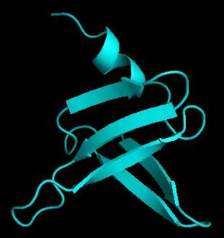Developing rcSso7d-based chimeric antigen receptors
PRINCIPAL INVESTIGATOR: CHRISTIAN OBINGER
Background.
Adoptive immunotherapy with T cells expressing chimeric antigen receptors (CARs) is one of the most promising strategies for the treatment of cancer. CARs are fusion proteins of – mostly – antibody derived antigen binding domains and signaling domains, derived from the TCR-complex and costimulatory receptors, which together strongly activate the T cells upon binding of tumor associated antigens (TAAs) on the tumor cell surface.
Despite impressive clinical successes, especially in the treatment of B-cell leukemia, CAR-T cell therapy is still in its infancy. One problem associated with CARs is the use of single-chain variable fragments (scFvs). These antibody fragments are often unstable and show low expression yields, especially when fused to other proteins such as the CAR backbone. Moreover, the fact that each scFv consists of two variable domains derived from the antibody heavy and light chain (VH and VL, respectively), bears the risk of cross-pairing with neighboring molecules.
In this project these drawbacks of CARs will be addressed by replacing scFvs with the alternative binder scaffold rcSso7d. rcSso7d is a charge-reduced version of the Sso7d protein derived from the hyperthermophilic organism Sulfolobus solfataricus. rcSso7d is a small (7 kDa) highly stable (Tm of 95°C), single-domain protein that has been engineered for binding to various antigens (Traxelmayr, submitted). Importantly, thermal stability of proteins has been shown to correlate with expression density (Schusta et al 1999 & 2000). Thus, we hypothesize that replacing scFvs with highly stable rcSso7d-based binders will result in increased CAR-expression on T cells. Furthermore, the single-domain nature of rcSso7d eliminates the risk of cross-pairing with other CAR-molecules.

Aims and methods.
The aim of the project is the development and detailed characterization of rcSso7d-based CARs.
First, rcSso7d mutants will be selected for binding to TAAs by using yeast surface display technology. Next, selected binders will be analyzed with regard to their affinity by titration on yeast, as well as by biolayer interferometry. Furthermore, stabilities and aggregation behaviors of antigen-binding mutants will be analyzed by differential scanning calorimetry (DSC) and size exclusion chromatography (SEC), respectively.
The most promising candidates will be cloned into the CAR backbone and tested for their ability to activate T cells in response to TAA-positive target cells in vitro and in vivo. T cell activation will be analyzed in vitro by measuring degranulation based on FACS analysis of CD107a surface expression, release of interferon-gamma and cytolysis of target cells using Europium release assay. The in vivo efficacy of the CAR-T cells will be tested in an NSG-mouse model for sarcoma.
In order to investigate whether usage of rcSso7d indeed improves the biophysical properties of CARs, expression densities of a set of rcSso7d-based CARs on T cells will be compared to those of scFv-based CARs. Furthermore, we will compare expression levels among different rcSso7d-based CARs and test whether the above mentioned correlation between expression density and thermal stability of proteins also holds true when rcSso7d mutants of different stability are incorporated into a large fusion construct, such as a CAR.
Traxlmayr, M. W. et al. Strong enrichment of aromatic residues in binding sites from a charge-neutralized hyperthermostable Sso7d scaffold library. submitted
Shusta, E. V, Holler, P. D., Kieke, M. C., Kranz, D. M., Wittrup, K. D. (2000) Directed evolution of a stable scaffold for T-cell receptor engineering. Nat. Biotechnol. 18, 754–759.
Shusta, E. V, Kieke, M. C., Parke, E., Kranz, D. M., Wittrup, K. D. (1999) Yeast polypeptide fusion surface display levels predict thermal stability and soluble secretion efficiency. J. Mol. Biol. 292, 949–956.
